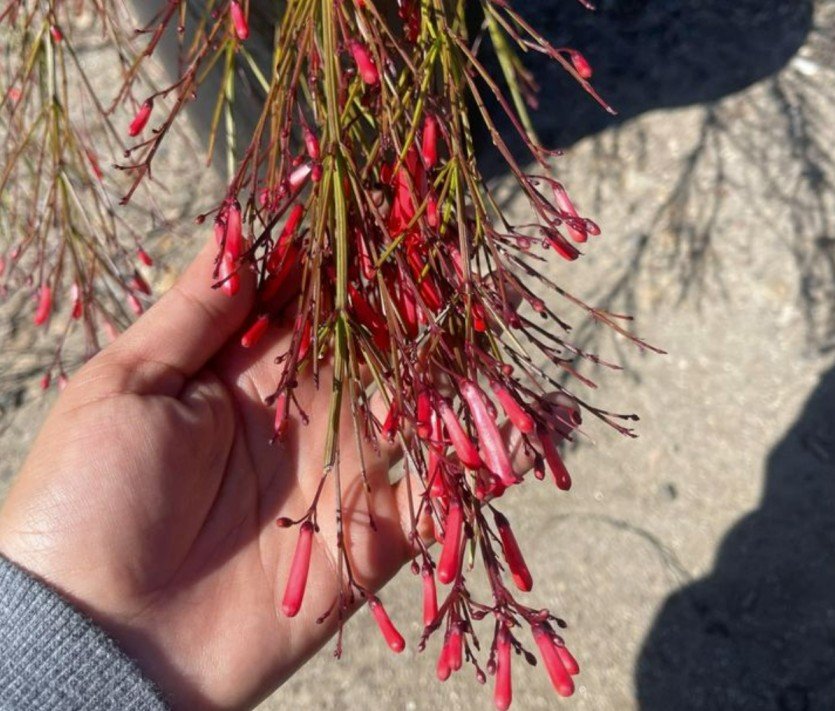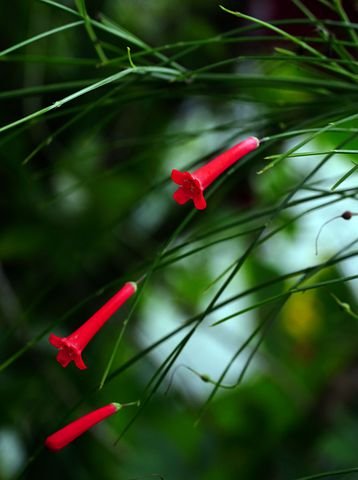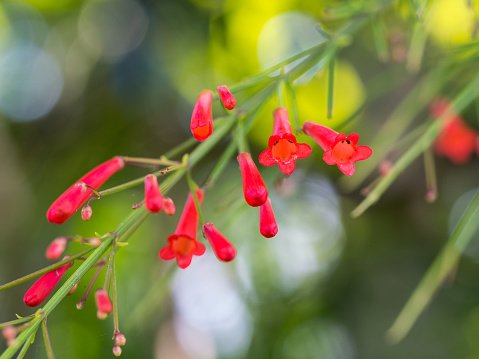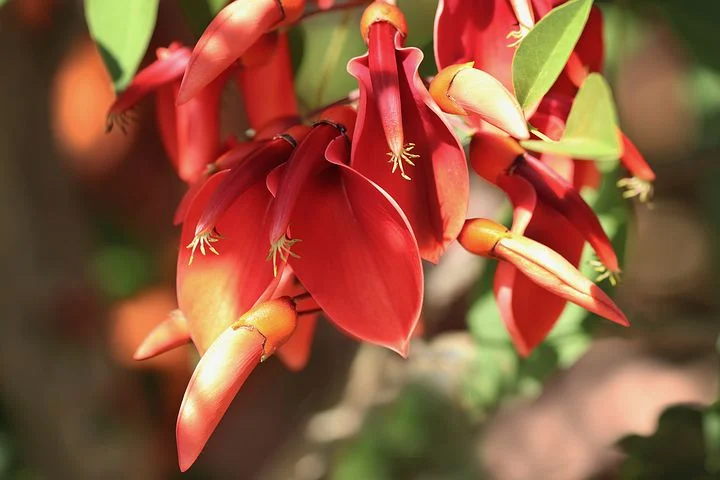Have you ever seen those plants with weeping shrubs and long sprays of orange-red flowers? Yes. They are called firecracker plants, and they go by this name because their flowers look like firecrackers.
Firecracker plants are commonly known as Russelia equisetiformis, and they are perennial plants that originate from Mexico.
They are equally called Fountain brushes, coral fountains, fountain plants, etc. However, the firecracker plant looks like the weeping willow; it is said to be one of the weeping subshrubs. Like the weeping willows, the firecracker plant has very long stems and leaves that look like scales.
The Firecracker plant is a frost-tender plant, and it doesn’t do well in cold temperatures, so it is advisable to bring it back indoors when the temperature drops in Autumn. In addition, the plant can flower at any time of the year when it is given enough warmth and light. Though the Firecracker Plants can tolerate partial trade, they require enough sun to thrive and blossom.
The Flowers attract sunbirds and are available in various colors ranging from red, yellow, and salmon. Their vibrant color and tubular shape make them excellent hummingbird attractors.
Types of Firecracker Plants
1. Hummingbird Plant

The Hummingbird Plant is also known as the Uruguayan Firecracker Plant or Russelia equisetiformis. It attracts Hummingbirds with its bright blooms and can perform best in full sun. The Hummingbird Plant can also tolerate partial shade but brings out the most bloom when placed under direct sunlight.
2. Firecracker Fern

Firecracker Fern is also known as the Coral Fountain Plant. It looks like a Fountain of green delicate textured stems covered in colorful tubular flowers. It is displayed in containers, raised beds, and walls.
The Firecracker Fern attracts hummingbirds and butterflies and likes full sun or partial shade. The Firecracker Fern needs rich, fertile, well-drained soil, and it is excellent to use in Floral arrangements.
3. Coral Plants

Coral Plants are also called Guatemala Thurburb and Jatropha multifida. It is a single-trunked small tree or shrub native to Mexico and Central America. The plant can grow 6 to 10 feet tall and 20 feet in its native habitat.
It is also an extremely sensitive specimen that can be killed if its temperature drops below 40 degrees Fahrenheit. The Coral Plant requires moderate fertile soil and good drainage, and it performs best with regular watering in an entire sun situation.
4. Coral Fountain Bush

Coral Fountain Bush is a fast-growing and easy to cultivate type of bloom. It is a must-have for the tropical butterfly garden. It is grown in containers and displayed in hanging clusters.
Uses of Firecracker Plants
The Firecracker Plants can also be termed a bushy suburb with narrow green leaves and bright pink or yellow flowers tube-like. It can also be beautiful and can be used for various reasons.
1. Economic value
The Firecracker Plants can be used as a hedge or ground cover or as a potted plant or ornament for landscaping.
2. Medicinal Benefits
According to (Ojurongbe et al, 2015), The Firecracker plant is cultivated in Mexico, Central America, and Africa as a medicinal plant. It is also used to treat kidney diseases, inflammation, pain, malaria, leukemia, diabetes, and promote hair growth.
3. Environmental Benefits
The Firecracker Plant controls erosion or dune stabilization. It helps with landscape improvement and wildlife habitat.
Below Are Tips That Will Serve As A Guide On How To Care For Firecracker Plants
1. Light
Full sun and exposure are required for most real growth and flowering. If you want to grow your firecracker plant indoors, always remember to keep it in an uncrowded area where it can receive bright light and a little morning sun. They also grow well under fluorescent grow lights.
2. Temperature
The ideal temperature for a firecracker plant is between 65 and 75 degrees Fahrenheit and between 18 and 24 degrees Celsius. The plant flourishes in warm temperatures, but it is not tolerant of freezing winter temperatures, so ensure to move the plant indoors where the temperature is favorable.
3. Soil
Every plant has soil it flourishes in. The Firecracker Plant flourishes in various soil types provided the soil is well-drained. It tolerates sandy, loamy, clay, and even garden soil. It also thrives best when the soil pH level ranges from alkaline to acidic.
4. Fertilizing
The plants are fed every two weeks using a half-strength diluted balanced liquid fertilizer. In Winter, the plants are meant to be fed monthly.
5. Pruning
Pruning helps remove any dead parts of the plant and attain the desired shape. Pruning off stems that have already flowered gives room for more flowers. Once the flowering period is over, Prune again to get new flowers.
6. Propagation
You can choose to propagate your Firecracker plants by cutting only the stem tips during spring.
Here Are A Few Steps Propagation Can Be Done
- Choose a healthy tip with a minimum of 2 leaves around 6” inches long.
- Remove all leaves.
- Make a small scratch on the bottom of the cutting before dipping the end into rooting powder.
- Shake off the excess powder
- Place the cutting into a pot of well-drained soil and water lightly.
- Enclosed in a plastic bag and set it in an area with indirect light with a temperature higher than 50°degree Fahrenheit.
Pests And Problems Of The Firecracker Plants
The Firecracker plants are occasionally bothered by chewing insects, nematodes, and mites. The only solution is to isolate them from other plants and ensure they haven’t been infected.
Rubbing alcohol can be used to get rid of mites, and as for nematodes, the best method is to maintain a healthy growing area so there won’t be any need for the use of chemicals on the plant.
Firecracker Companion Plants
Good companion plants for the firecracker plants include Hibiscus, Chenille Plant, Silver Buttonwood, Nandina, and Burgundy Loropetalum.
Frequently Asked Questions
Where is the best place to plant a Firecracker Plant?
Firecracker plants first became famous as indoor plants but have proven to be good outdoor plants. However, you can choose to plant a Firecracker Plant indoor or outdoor, but always keep in mind that wherever you choose to plant, it must be in an area with full sun and exposure to good draining soil that retains some moisture.
Are Firecrackers Plants Poisonous?
Though Firecracker plants attract hummingbirds and can be worsened if not kept under control, moreover, there is no indication that any of these plants are Poisonous.
Do Firecracker Plants Spread?
Yes, it does. As long as it is given some space and displayed in a way, it can show off the fine-textured foliage covered with bright flower clusters. This way, the plant can spread widely.
Should I Prune A Firecracker Plant?
The Firecracker Plant proliferates and should be pruned sometimes, if not all the time. Pruning helps attain desired shapes and remove the dead parts of the plants.
Do Firecracker Plants Attract Hummingbirds?
The Firecracker Plants attract Hummingbirds, butterflies, and other pollinators because of the explosive impact on the garden.
